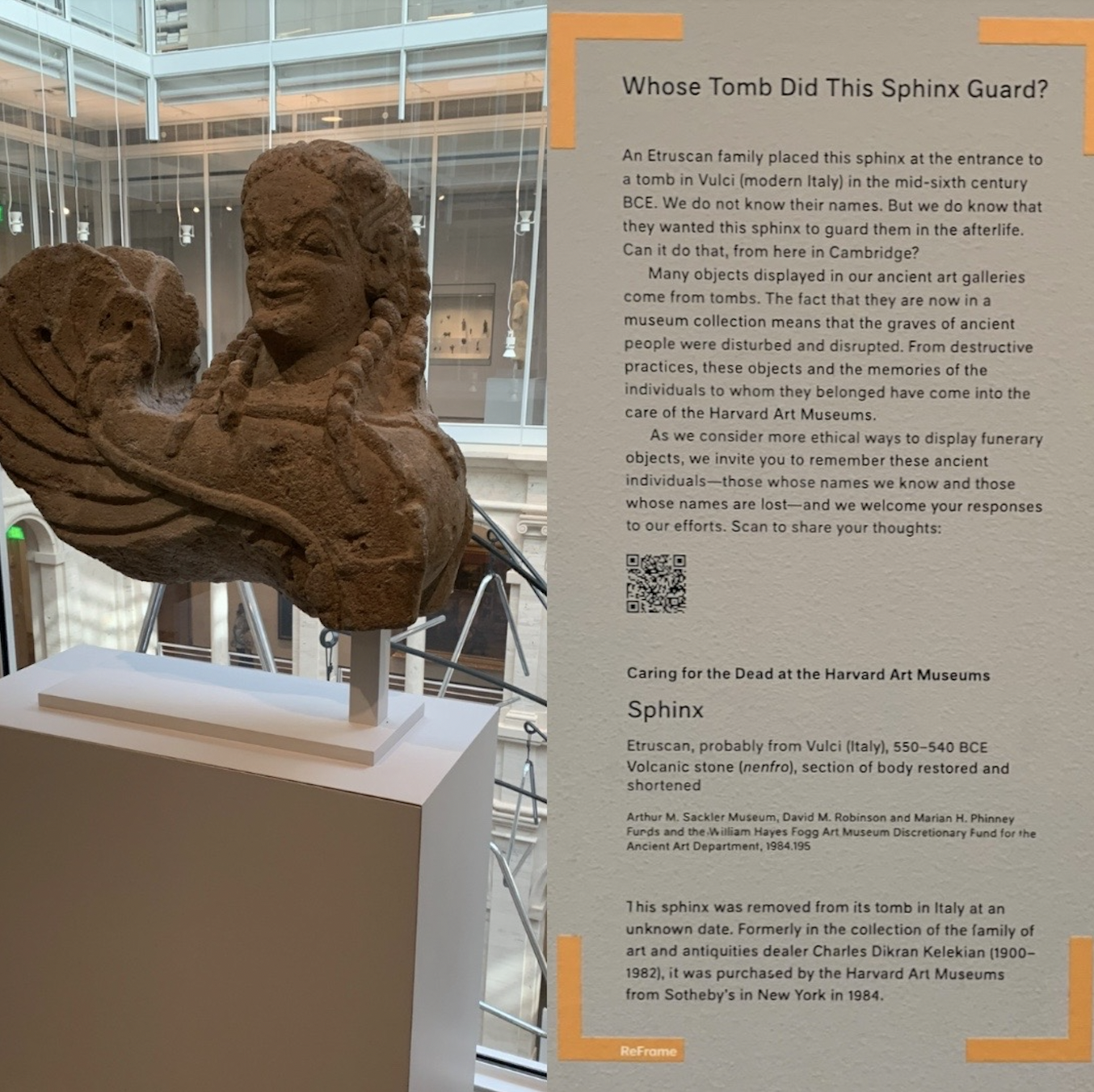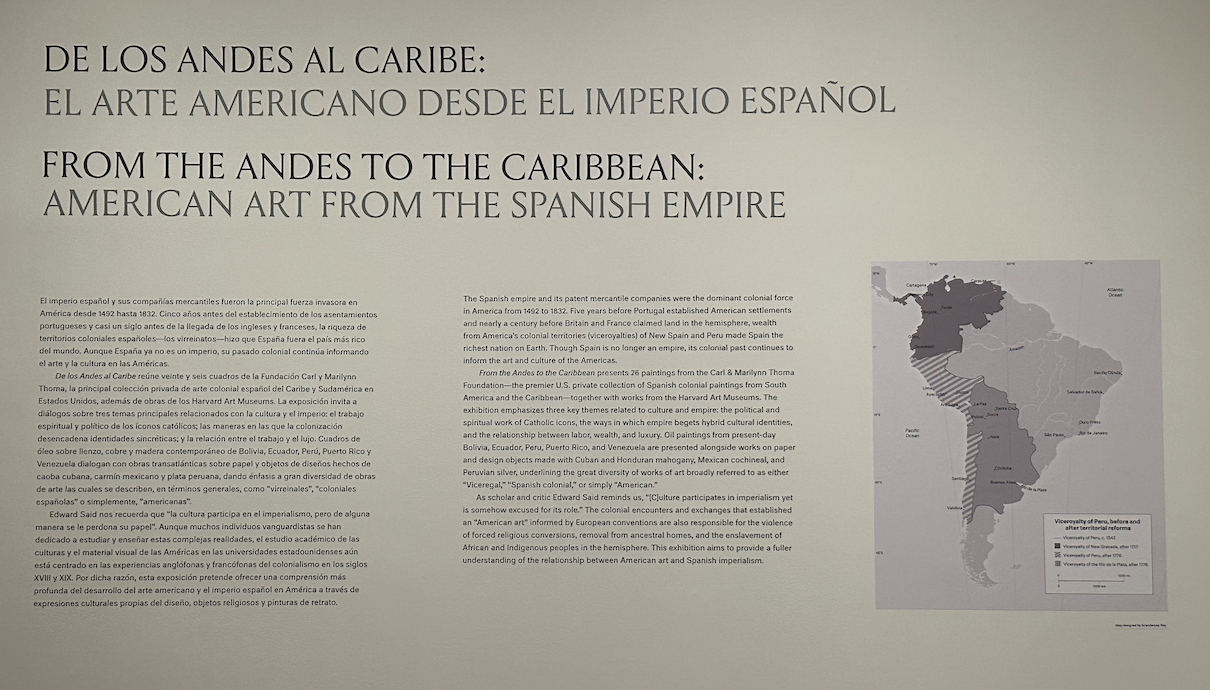Reframing the Harvard Art Museums
Existing ReFrames: a Sphinx and a Falcon
Two existing ReFrames that I appreciate can be found on the third floor: “Whose Tomb is This Sphinx Guarding?” and “Horus falcon wearing crown of Upper and Lower Egypt with uraeus.”

Something that has come up in a few conversations with one of my colleagues is that of provenance, especially in regard to ancient Egyptian work: the Sphinx points toward those conversations. The Sphinx’s ReFrame asks us to consider the meaning of this piece of art in the context of Cambridge versus that of its original intention. There are a number of objects at H/AM and at museums around the world that were originally from tombs, meant to guard a body in its afterlife. What I appreciate about this ReFrame is that it asks us to reckon with this: “Can it guard someone in the afterlife from here in Cambridge?” The label further invites viewers to share what they think regarding funerary objects and ethical display via QR code. In terms of improvement, I wonder how the experience of this conversation would change if visitors were able to see what others think as well–if the QR code led to more of a blog-format than a single response survey on Qualtrics.

Around the corner from the Sphinx, you’ll find the Horus Falcon with its accompanying ReFrame. I chose this ReFrame to highlight because it feels unique to the ReFrame project. Many of the ReFrame labels throughout the museum connect strongest to the mission to “shine a light on difficult histories” and “investigate untold narratives,” but the falcon label seems aimed to highlight something a little different from that, or unexpected: science. Rather than asking us to engage with cultures seen and unseen, this label highlights some of the interesting conservation work that is done at H/AM. Inside of this bronze falcon is another falcon, one that has been mummified and discovered in an X-radiograph, discovered during routine conservation efforts at the museum. Something that I love, and I know some of the students I’ve worked with this year appreciate too, is when museums make efforts to bring the behind-the-scenes highlights to the fore, and I think that this ReFrame label does just that. Along with the science behind the ReFrame, it also asks us to consider devotional objects, but doesn’t go quite as far as to ask us how to think about them. At the end of the ReFrame, the curator points out that this object is the “remains of a prayer to [Horus],” which, I think, begs the question: what is the (ethical) place of devotional objects in museum spaces? I wonder if this ReFrame could’ve been another opportunity to spark institutional understanding and critique, to push visitors to consider this and discuss it with others.
Considering a new ReFrame: Special Exhibits

Although many of the ReFrame objects are single objects, there are a few throughout the museum that highlight entire galleries (“New Images of Humankind,” for example). I think a potential missed opportunity within the ReFrame project is the chance to highlight the special exhibits through a ReFrame lens as well. Many of the special exhibits in the museum uphold “difficult histories, investigate untold narratives, and experiment with different approaches to storytelling,” but they are not necessarily highlighted with the frame. If I were visiting the museum and intrigued by the ReFrame labels specifically, this might lead me to miss out on some larger conversations within the museum. For example, a new exhibit just opened: “De Los Andes Al Caribe,” and the curator aimed, through the exhibit, to signal a shift in ways that American art is discussed at the museum–away from an art of region and toward an art of hemispheric understanding. One way that they aimed to do this is to orient visitors in the room to think about how we define “America” versus “Americas.” The exhibit is unique, at least in H/AM, with multilingual chat labels, further uplifting a shift in ways that we think about the artists of the Americas by including first the language of the artist, then the English label to follow (if it is not the native language of the artist). All of this to say, this special exhibit considers many layers of institutional questioning that align with the objective of the ReFrame label, but is not noted as such. I do wonder if a ReFrame label would ask more visitors to consider the exhibit through a new lens or approach, though I think the gallery and chat labels do a lot of heavy lifting when it comes to upholding questions of cultures seen and unseen.